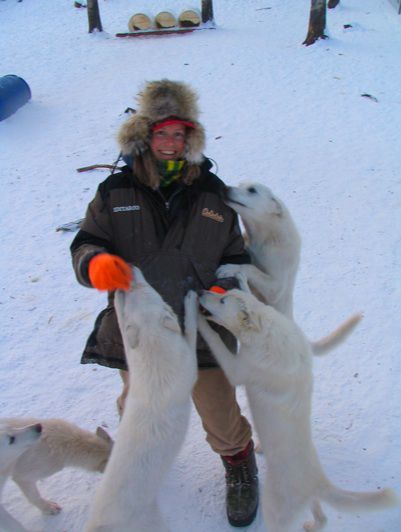Some information may be outdated.
When most people think of an Alaskan sled dog charging through the snow, they might think of a big, furry, muscled work dog. That image makes Iditarod musher Karen Land laugh.
“People expect my dog Noggin to be a thick, fluffy dog and can be disappointed – she’s a sweet, skinny thing that barely weighs 50 pounds,” Land said, explaining that the athletic dogs are built more like marathon runners, not bodybuilders.
The Iditarod is an annual Alaskan sled dog race that runs over the remote country between Anchorage and Nome. The human sled leaders, called mushers, work with teams of dogs to cover over 1,000 miles in just days.
Children and adults alike are welcome to hear Land speak about the race and to meet Noggin at Star Hall (159 E. Center St.) on Wednesday, Nov. 20, at 6 p.m. The talk is sponsored by the Grand County Public Library.
“So many people think the Iditarod sounds so crazy that people have a hard time fathoming the idea of being out there in the cold. But having my dog there with me when I talk about it makes it make sense,” Land said.
Noggin is an Alaskan Husky, a breed that descends from dogs that worked in Athabaskan villages. Now, the breed is mostly used for sled racing and rarely for pulling any heavy loads.
The love of dogs and animal training is what attracted Land to the sport to begin with. After meeting a few people who participated in sled dog races, Land immediately knew she wanted to be a part of the community and have a dog kennel of her own.
“That’s how I got into mushing: I adore dogs,” said Land. “When people hang out with sled dogs, I think people think they’re going to be strange. But really they’re just big babies.”
One of the reasons that sled dogs don’t look quite like the fluffy, thick-furred stereotype is that the dogs are now bred for warmer weather.
“The dogs are totally different, everything has changed due to changes in the weather,” said Land. “It’s affected the Iditarod a lot in the last few years. We used to send food to Alaska to pick up in remote areas during the race and it just would stay frozen at checkpoints. Now we have to think about how we’re feeding the dogs, since things have been warmer and the food melts.”
Land said that the Iditarod’s course has also had to change, since low snow levels and a lack of ice on waterways make old courses impossible to run.
Later, Land ran into a schoolteacher who invited her to speak to her students about the dogs and the Iditarod race.
“Her enthusiasm was so infectious, not to mention the kids,” said Land, “that I realized what a great thing it was to get this to kids who might not get to do a lot of outdoor activities.”
Land has been bringing Noggin and her other dogs to speaking engagements at libraries, schoolrooms and elsewhere ever since.
“I’ve been really fortunate to travel with my dogs and go all over the country,” said Land “but I’m always so honored to work with libraries and see how much they offer to their communities, including programming like this.”
For more information, contact the Grand County Public Library at 435-259-1111.
“When people hang out with sled dogs, I think people think they’re going to be strange. But really they’re just big babies.”
– Karen Land
When: Wednesday, Nov. 20 at 6 p.m.
Where: Star Hall, 159 E. Center St.
Cost: Free
Contact: 435-259-1111
Iditarod racer and her canine visit Moab
Appreciate the coverage? Help keep local news alive.
Chip in to support the Moab Sun News.





